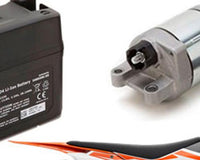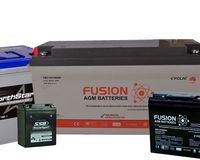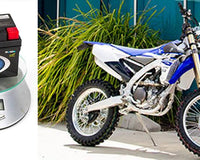C batteries are another household favorite dry cell. Like the AA, AAA, and D, these are also cylindrical. In this article, I will walk you through the nature of C cells, their types, applications, and other features and benefits to help you get the most of your devices anytime, anywhere.
C BATTERIES – UNDERSTANDING THE NATURE AND FEATURES OF A C BATTERY
Do you know what C batteries are? How about its characteristics? What are its unique battery features? What devices or applications use the C-size battery?
These questions will guide you in understanding the C batteries fully and how you can get the most benefits out of its features for your favorite applications or devices. C batteries are also known as R14 from the International Electrotechnical Commission (IEC) designation. This standard size battery is larger than the AA batteries and AAA batteries. However, it is a bit smaller than D batteries. The C-size belongs to the dry cell group as it is for operating at minimum internal moisture. It makes it ideal for portable devices.
The C size-battery is 1.97 inches or 50.0 mm in length and 1.03 inches or 26.2 mm in diameter. This standard battery comes as both primary and rechargeable batteries. Battery capacity and voltage depend on the chemistry of the cell. C batteries are for devices that require medium to high power consumption. Typical applications are for musical instruments, flashlights, toys, and other related applications.
C-SIZE PRIMARY BATTERY
The C-size primary battery is a non-rechargeable or disposable battery. This throwaway battery has a battery life that varies on its chemistry and other factors regarding usage. This dry cell can have such battery chemistry as Alkaline, Lithium, Lithium Manganese Dioxide, Lithium Sulfuryl Chloride, Lithium Thionyl Chloride , Lithium Bromine Chloride, Lithium Poly-carbon monofluoride, Carbon Zinc, Nickel Metal Hydride, and Nickel Cadmium, among others.
ALKALINE
The Alkaline C size-battery is a popular primary battery because of its affordability and wide availability and accessibility. It is on shelves in almost all convenience stores, department stores, battery wholesalers, and even smaller shops near you. The Alkaline C cell has a nominal voltage of 1.5V. Most Alkaline batteries have longer shelf lives. Though some are prone to leakage, others are re-engineered to be almost leak-free and even more durable than before. Some popular Alkaline C batteries you can trust are Duracell Coppertop C size batteries for such applications as basic radio, flashlights, motorized toys, automatic faucets, and wall clocks. Duracell-Procell Industrial C is another great power solution for its lower operating costs due to increased battery life. It is also re-designed to meet the longevity and durability's highest standards for professional use. Procell INTENSE Power C is for high drain devices. It is intended for such devices as soap dispensers, automatic odorize, hand sanitizer, high-intensity flashlights, and other high drain applications. Other superior quality batteries are Energizer C Industrial, Energizer Max C, and Energizer Max Plus Advanced C for blood pressure monitor, motorized blinds, automatic faucet, remote security cameras, and other related applications. Panasonic LR14XW Industrial Grade C, Fujitsu High Power L14C, Fujitsu Universal Power C, and Fujitsu Universal Power 1.5V C cells are among the top C-size Alkaline batteries here.

PRIMARY LITHIUM
The primary Lithium or Lithium C batteries are non-disposable cell variants. These may have a voltage of 3.6 volts with varying mAh ratings. The battery's run time usually depends on the mAh rating. So, a higher rating means a longer run time.
Here are the major characteristics of primary Lithium.
- Longer shelf life than most Alkaline batteries
- Last for more years when used in the right applications and devices
- More costly compared to Alkaline cells
- Not leak-prone
RECHARGEABLE C BATTERIES
Rechargeable C batteries are of such chemistries as Lithium-ion, Lithium Polymer, and other Lithium-based variants. Nickel Cadmium (NiCad) and Nickel Metal Hydride (NiMH). Unlike the primary variants, the rechargeable C batteries are convenient for most people as these are more reliable because of its durability than the disposable ones. As the term implies, you will need a compatible charger for your respective C-size rechargeable batteries. You can buy a rechargeable C-size battery with charger in combo packs in most convenience stores, direct suppliers, and battery wholesalers.
Rechargeable C batteries, compared to their other battery counterparts, are known for their long-lasting performance and extended battery life. Because it can be used for the long term, rechargeable C batteries are a much better option as it is economical and can be recharged up from 500 to 800 times.
Usually, when you purchase a rechargeable C size-battery it comes with a separate charger for your convenience. Alternatively, some are conveniently built into the device like flashlights, musical instruments, and some toys. Different types of rechargeable C batteries include Lithium-Ion, NiCd, and NiMH.
RECHARGEABLE LITHIUM
Rechargeable batteries also come in Lithium-ion or other Lithium-based battery packs. These are for laptops, PLC, and other related applications. Rechargeable Lithium cells are usually costly yet lighter than others.

NICKEL CADMIUM (NiCad)
Nickel Cadmium is a rechargeable battery with a memory effect . It is toxic to the environment. It also possesses a low energy density. However, there are still some conditions wherein consumers prefer using NiCad batteries . Consider such factors as economical price, high discharge rate, high temperature, fast charge time, and long life. Most consumers and business owners still use NiCad chemistry in their daily tasks. These batteries are for such devices as biomedical equipment, power tools, two-way radios, and professional video cameras.
NICKEL METAL HYDRIDE (NiMH)
Nickel Metal Hydride or the NiMH chemistry is another rechargeable battery that has its C standard size. Compared to the NiCad variant, its energy density is higher. NiMH batteries are environmentally friendly as they do not have toxic metals and are recyclable. The cycle durability of NiMH batteries ranges from 180 to 2000 cycles. NiMH batteries have an energy density that ranges from 140 to 300 Wh/L. NiMH batteries have specific power ranging from 60-120 Wh/kg. The battery's "specific power" ranges from 250 to 1000 Wh/kg. NiMH batteries have a nominal cell voltage of 1.2 volts C batteries, in general, have varying voltages.
C-SIZE BATTERY VOLTAGES
Voltage is the strength of the battery's electrical charge. Nominal cell voltages distinguish batteries. The nominal voltage of a cell defines the battery's capacity in ideal condition.
1.5V C-size Batteries
1.5V is common in primary C batteries. The C batteries having 1.5V nominal voltage are for most daily household items.
Typical Applications:
- Toys
- Remote controls
- Radios
- Clocks
- Musical Instruments
3V C Batteries
C batteries having 3V nominal cell voltage are rare in daily domestic applications. They are commonly used as professional batteries by various industries for professional applications.
Typical Applications:
- Monitoring oil tank level
- Mining applications
- Petrochemical facilities
- Smart gas meters
3.6V C Batteries
These batteries are higher in voltage and are for industrial and professional applications. These are mostly Lithium-based. These are for the new generation of micro-electronics. The battery's permanent connection to the circuit, in most cases, is designed for the application's reliable performance over a wide range of temperature conditions.
Typical Applications:
- Buoys
- Automatic meter and professional meter readers
- Professional Electronics
- Industrial Applications
- Measuring Equipment
When it comes to C-size battery voltages, you can also find C cells having 1.2V as the nominal voltage as NiMH C High Temperature, NiMH raised button high power cell, and many more.

THE BOTTOM LINE
C batteries are standard cylindrical batteries bigger than AAA and AA dry cells but smaller than D cells. The C-size cells come as both primary and rechargeable batteries. Know your batteries very well and the specific battery requirements for your devices. It will help you optimize the performance of both battery and device.
Battery chemistries have their unique characteristics, so a deeper understanding of battery chemistry, battery design and engineering, brand, and other variables play a crucial role in getting the best batteries for every application you have. Proper storage, handling, usage, disposal, and recycling measures are other factors that everyone must carefully practice.
There is no single rule to guide you in getting the best battery in the world as every battery is unique, designed for either low drain or high-drain application, and comes with other features that come with the cost. Find the most suitable battery replacement for your device. It will prolong not only battery life but also your device's performance.
C BATTERY FREQUENTLY ASKED QUESTIONS (FAQs)
Are C batteries recyclable?
Yes, C batteries are recyclable like any other battery. Battery manufacturers or some other third-party collection agencies collect these used cells. Ask your battery supplier, favorite stores, or state policies regarding battery disposal and recycling conditions to help save the environment.
How long do C batteries last?
The lifespan of a battery depends on various factors. However, to give you some estimates, C batteries can last for a maximum of 10 years in storage. On average, a standard C-size 1.5V battery can last for more than 18 hours when discharged at 200 mAh.
Here are some factors affecting battery life.
- Nominal voltage based on the cell type
- High drain or low drain
devices
- Application conditions regarding battery usage
- Voltage compatibility
- Brand's manufacturing process and materials used affect the overall quality
Are C batteries rechargeable?
Yes, C batteries are rechargeable. These batteries also have their non-rechargeable, single-use, disposable variants. These are called primary batteries. Thus, C batteries come as both disposable and rechargeable batteries.
Are C batteries allowed on planes?
Yes, C batteries are allowed on planes. C batteries belong to the big five household batteries allowed as both carry-on and checked bags during flights.
Are C batteries prone to leakage?
It depends on the chemistry and such conditions as usage, storage, temperature, and other related factors. It implies that, in some cases, a particular C-size battery can leak while others may not.
Why do C batteries leak?
C batteries, like any other battery, may leak. Corroding or leaking happens in Alkaline batteries than in Lithium or any chemistry. Leaving the batteries unattended for long periods causes this scenario. The continuous self-discharge occurs in tiny increments when you are not using the battery.
In the case of Alkaline batteries, the self-discharge process produces hydrogen gas in small amounts. However, these small amounts can cause pressure inside the battery over time. This buildup results in the leaking of corrosive material that should be removed and cleaned immediately.
Can C batteries explode?
Yes, C batteries can explode. All batteries have their explosive tendencies. It is the reason why you need to take good care of your batteries. It includes proper handling, storage, disposal, or even recycling measures.
What are volts and milliamp-hours?
These two ratings are present in all batteries. Amp-hours (Ah) or milliamp-hours (mAh) is the rating or measure of the amount of energy stored in a cell. It implies the number of hours a battery can last. Thus, if you are looking for a longer run time, go for a dry cell with a higher Ah. On the other hand, volts (V) are for voltage rating. You cannot choose any battery voltage on your own as every specific device's battery requirements. However, in some cases, you can find some devices requiring 3.6V. Replacing them with 3.7V batteries will still work right. The rule here is you should not exceed 1 volt higher than its original rating. It means that you can go for a 4.6V battery replacement on that application but not go far beyond that voltage.
Is it reasonable to store batteries in a refrigerator or freezer?
Some people claim that storing batteries in a refrigerator or freezer can prolong battery life. Exposing batteries to extreme temperatures can damage them in any way. The moist environment may cause condensation that will gradually cause rust or any other form of damage.
Are C batteries AC or DC?
Batteries are DC. It implies that the cells generate a voltage in just a single direction. These have a polarity of negative and positive. DC or direct current provides constant current or voltage.
Are C batteries affected by a magnet?
No, C batteries are not affected by a magnet. Magnetic fields do not have any effect on battery performance.
Why is mixing C batteries with various chemistries, type, and age a potential problem?
Mixing batteries will only increase battery leakage potential and reduce the run time of your devices. An energy or capacity imbalance will occur. Exhaustion will happen to the weakest battery. The new cells will then force discharge the weakest one to its lowest voltage levels, increasing leakage potential.
Where to buy the best C batteries for various applications?
HBPlus Battery Specialists gives you a wide range of C batteries for your desired applications. These batteries are made of original brands and the recommended battery replacements for all kinds of devices. The Battery Specialists offer bulk pricing options based on your specific battery requirements. Save more with bulk batteries. Feel free to contact us today!









